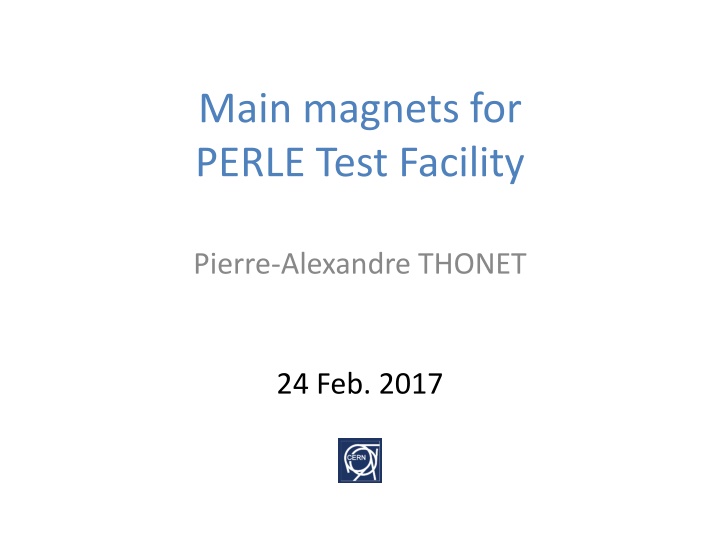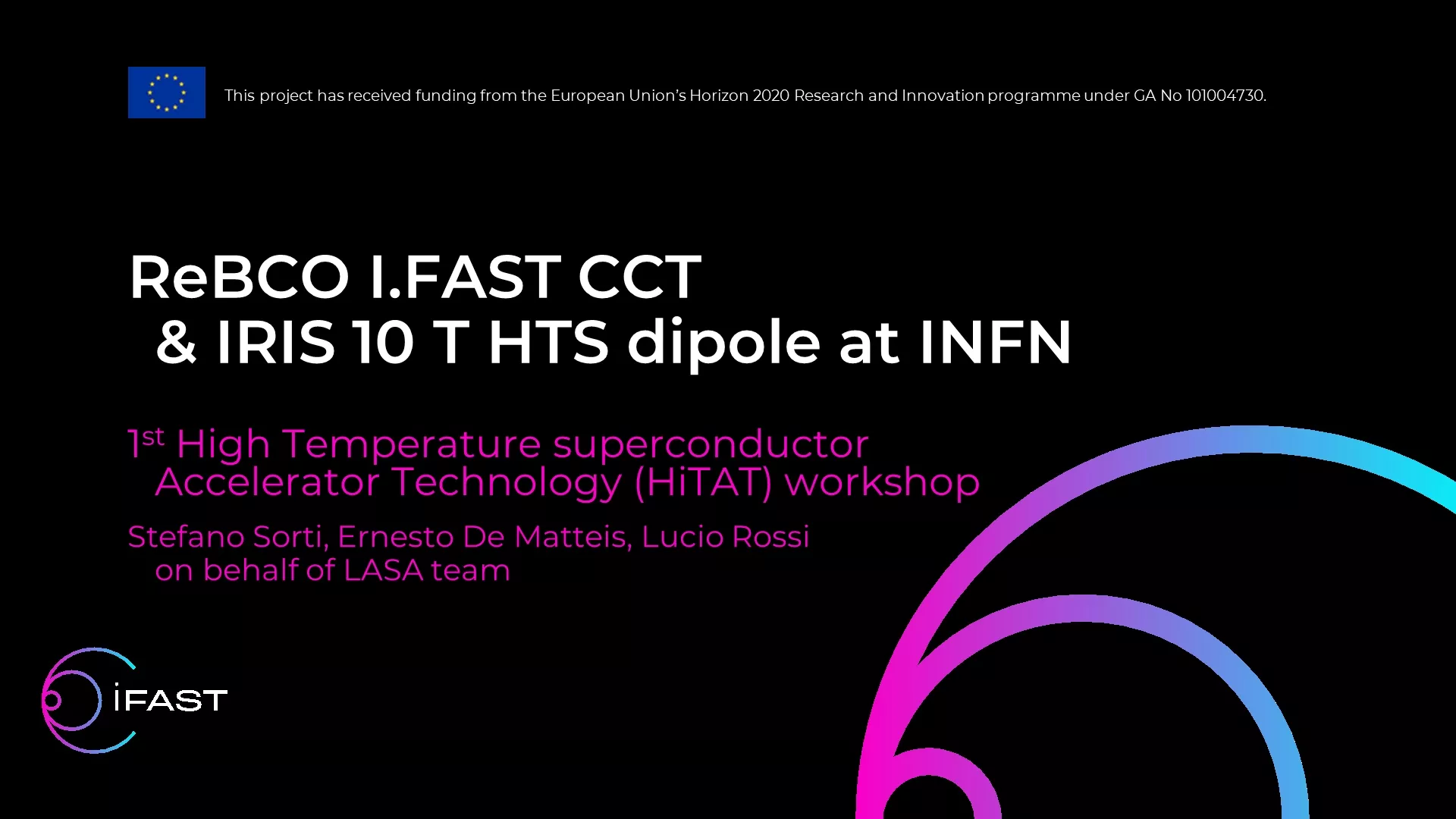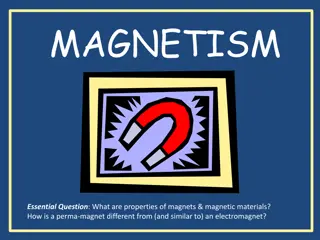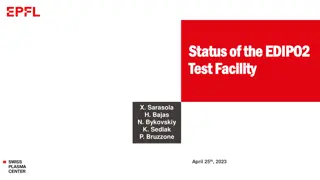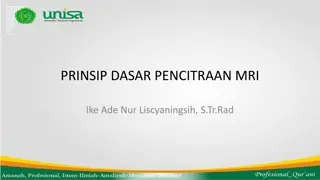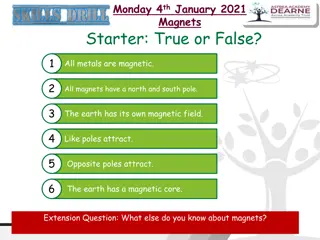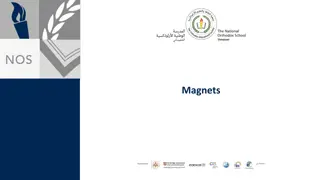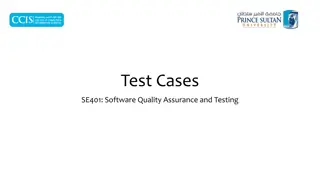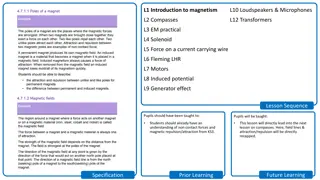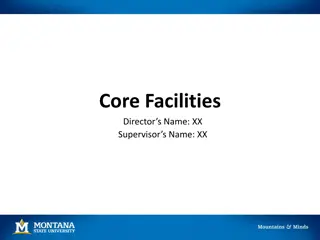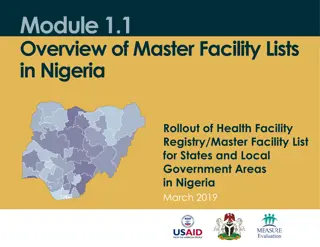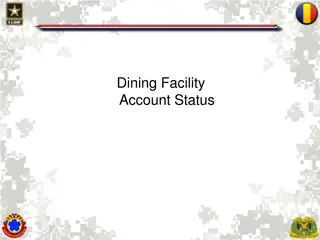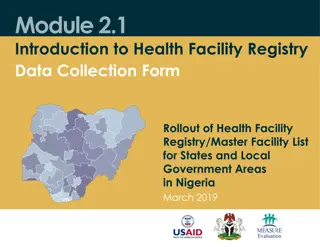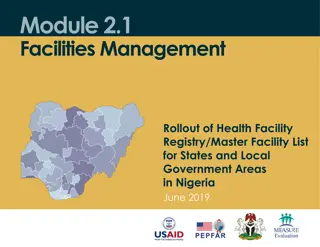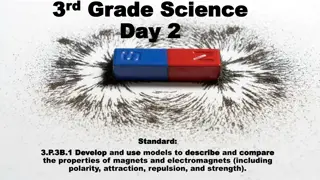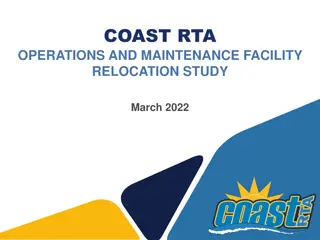Main Magnets for PERLE Test Facility Overview
Overview of the main magnets proposed for the PERLE Test Facility by A. Bogacz, including details on the magnet inventory, layouts, bending magnets, and alternative solutions. The design features horizontal bending magnets, quadrupoles, and a combination of magnet types to achieve the required integrated field for each bend.
Uploaded on Feb 23, 2025 | 1 Views
Download Presentation

Please find below an Image/Link to download the presentation.
The content on the website is provided AS IS for your information and personal use only. It may not be sold, licensed, or shared on other websites without obtaining consent from the author.If you encounter any issues during the download, it is possible that the publisher has removed the file from their server.
You are allowed to download the files provided on this website for personal or commercial use, subject to the condition that they are used lawfully. All files are the property of their respective owners.
The content on the website is provided AS IS for your information and personal use only. It may not be sold, licensed, or shared on other websites without obtaining consent from the author.
E N D
Presentation Transcript
Main magnets for PERLE Test Facility Pierre-Alexandre THONET 24 Feb. 2017
Overview New layout and magnet inventory proposed by A. Bogacz with an energy of 450 MeV Horizontal bending magnets o As proposed in the new magnet inventory o Alternative solution in order to reduce the number of magnets Quadrupoles 24 Feb. 2017 Pierre-Alexandre Thonet 2
Layout Perle@Orsay 450 MeV Top view 6 m 24 m 2 : 4 : 6 2 : 4 : 6 1 : 3 : 5 1 : 3 : 5 Side view 0.3 m + 0.3 m Courtesy A. Bogacz 24 Feb. 2017 Pierre-Alexandre Thonet 3
Magnet inventory Magnet Type Short Hor. Bend Long Hor. Bend Short Ver. Bend Long Ver. Bend Short B-com Long B-com Chic. Bend Short Quad Long Quad 15 30 15 30 15 30 5 10 20 Length [cm] 14 14 14 14 14 14 2 Field [kGauss] 3 3 Gradient [kGauss/cm] 6 12 7 12 7 8 7 8 7 6 5 6 5 2 S/R 1 4 Arc 1 6 2 S/R 2 4 Arc 2 6 4 S/R 3 4 4 Arc 3 6 4 S/R 4 8 Arc 4 2 2 6 2 6 2 S/R 5 4 8 Arc 5 6 S/R 6 12 Arc 6 6 Linacs Total 12 36 14 20 2 2 6 90 28 Bends: 92 Quads: 118 Courtesy A. Bogacz 24 Feb. 2017 Pierre-Alexandre Thonet 4
Horizontal bending magnets 24 Feb. 2017 Pierre-Alexandre Thonet 5
Bending magnets as in the magnet inventory All magnets work with the same magnetic field (the same power supply could be used to power all of the magnets at the same time) Operation in DC Magnet aperture of +/- 20 mm 2 magnet types with same cross section (yoke length of 0.15 and 0.3 m) The deflection angle changes function of the energy: straight magnet solution required H design in order to reduce the height of the magnet for stacking The required integrated field for each bend is obtained thanks to a combination of the 2 magnet types 24 Feb. 2017 Pierre-Alexandre Thonet 6
Cross section Central field: 1.4 T Aperture width: +/- 55 mm water cooled coils (the shaded area corresponds to 6-7 A/mm2) Relatively large cross section of the magnet compared to the aperture size Due to its width, the same magnet cannot be used for horizontal and vertical deflection 24 Feb. 2017 Pierre-Alexandre Thonet 7
Alternative solution Longer and curved bending magnets 2 different magnet types with same cross section (only the length changes) Only 1 magnet per bend with a deflection of 45 Reduction of magnet number (24 compared to 48), could help to reduce cost Energy [MeV] Curv. radius [mm] GFR width [mm] angle [deg] B [T] L Pole gap [mm] Arc Count [mm] #1 80 4 45 0.45 456 596 20 20 #2 155 4 45 0.87 456 596 20 20 MBA #3 230 4 45 1.29 456 596 20 20 #4 305 4 45 0.85 912 1191 20 20 #5 380 4 45 1.06 912 1191 20 20 MBB #6 455 4 45 1.27 912 1191 20 20 24 Feb. 2017 Pierre-Alexandre Thonet 8
Alternative solution initial part of combiner not considered initial part of spreader not considered 24 Feb. 2017 Pierre-Alexandre Thonet 9
Solution 1: independent power supplies 1 power convertor for each arc Central field: 0.45 to 1.29 T The use of the same magnet for horizontal and vertical deflection seems possible Water cooled coils (the shaded area corresponds to 6-7 A/mm2) Yokes possibly machined 24 Feb. 2017 Pierre-Alexandre Thonet 10
Solution 2: single power supply 1 power convertor for all horizontal magnets The magnetic field is settled by changing the number of conductor layers (i.e. number of turns) in the coils 2 turns are added in order to compensate the non linearity of the magnetic field for the different arcs due to the injection energy (5 MeV) Number of layers for each coil Int. field Bdl [T.m] B [T] L arc [mm] #1 0.45 456 2 0.21 #2 0.87 456 4 0.40 #3 1.29 456 6 0.59 #4 0.85 912 4 0.77 #5 1.06 912 5 0.97 #6 1.27 912 6 1.16 24 Feb. 2017 Pierre-Alexandre Thonet 11
Quadrupoles 24 Feb. 2017 Pierre-Alexandre Thonet 12
Quadrupoles In total 118 quadrupoles are required Same aperture diameter of 40 mm for all arcs 2 magnetic lengths, 100 mm and 200 mm Maximum gradient: 30 T/m Operation in DC 24 Feb. 2017 Pierre-Alexandre Thonet 13
Quadrupoles: cross-section water cooled coils, to be designed as part of overall optimization including yoke height, power converters, magnet manufacturing cost and operational scenario (the shaded area corresponds to 7-8 A/mm2 at max field) 24 Feb. 2017 Pierre-Alexandre Thonet 14
Conclusion 24 Feb. 2017 Pierre-Alexandre Thonet 15
Conclusions The last inventory of the magnets of Perle@Orsay Test Facility lists: 92 bending magnets (vertical and horizontal field) 118 quadrupole magnets Conventional iron-dominated resistive magnets can be used Grouping the magnets in families has to be analysed to possibly reduce the number of magnets (for example with longer and curved dipoles) The spreader and combiner regions need to be studied in detail since space is rather tight. The need for dipole correctors has to be evaluated. They could possibly be added to some quadrupoles. 24 Feb. 2017 Pierre-Alexandre Thonet 16
Many thanks to Alessandra Valloni and Alex Bogacz. Thank you. 24 Feb. 2017 Pierre-Alexandre Thonet 17
